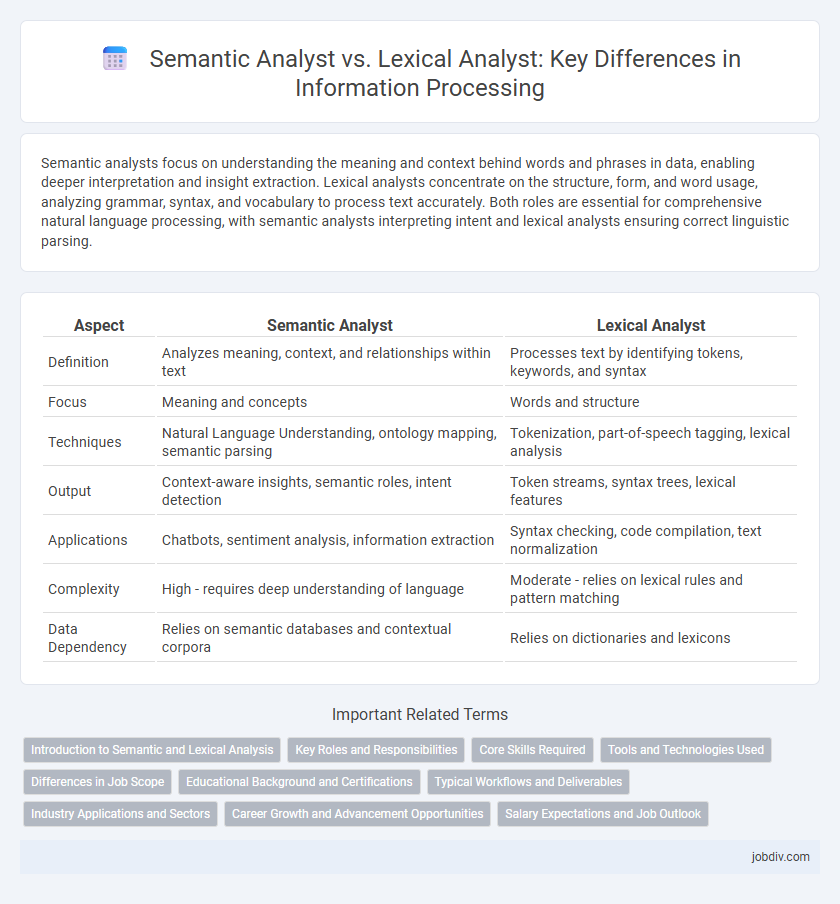Semantic analysts focus on understanding the meaning and context behind words and phrases in data, enabling deeper interpretation and insight extraction. Lexical analysts concentrate on the structure, form, and word usage, analyzing grammar, syntax, and vocabulary to process text accurately. Both roles are essential for comprehensive natural language processing, with semantic analysts interpreting intent and lexical analysts ensuring correct linguistic parsing.
Table of Comparison
| Aspect | Semantic Analyst | Lexical Analyst |
|---|---|---|
| Definition | Analyzes meaning, context, and relationships within text | Processes text by identifying tokens, keywords, and syntax |
| Focus | Meaning and concepts | Words and structure |
| Techniques | Natural Language Understanding, ontology mapping, semantic parsing | Tokenization, part-of-speech tagging, lexical analysis |
| Output | Context-aware insights, semantic roles, intent detection | Token streams, syntax trees, lexical features |
| Applications | Chatbots, sentiment analysis, information extraction | Syntax checking, code compilation, text normalization |
| Complexity | High - requires deep understanding of language | Moderate - relies on lexical rules and pattern matching |
| Data Dependency | Relies on semantic databases and contextual corpora | Relies on dictionaries and lexicons |
Introduction to Semantic and Lexical Analysis
Semantic analysis involves interpreting the meaning and relationships of words within context to extract deeper understanding from text, utilizing techniques like entity recognition and sentiment analysis. Lexical analysis focuses on breaking down text into tokens such as words and symbols, serving as the foundational step in natural language processing by identifying word boundaries and parts of speech. Together, semantic and lexical analysis enable comprehensive text interpretation by combining structural tokenization with meaning extraction.
Key Roles and Responsibilities
Semantic Analysts focus on interpreting the meaning and context behind data, ensuring accurate understanding of user intent and improving information retrieval systems. Lexical Analysts specialize in analyzing the structure and form of language, such as syntax, morphology, and word patterns, to enhance language processing models. Both roles collaborate to optimize natural language processing by integrating semantic understanding with lexical analysis techniques.
Core Skills Required
Semantic analysts require deep expertise in natural language understanding, including semantic parsing, ontology development, and context-aware interpretation. Lexical analysts focus on skills such as morphological analysis, word segmentation, and part-of-speech tagging to process language at the word level. Proficiency in linguistic theory, machine learning, and data annotation tools is essential for both roles.
Tools and Technologies Used
Semantic analysts utilize advanced natural language processing (NLP) tools like IBM Watson, spaCy, and Google Cloud Natural Language API to interpret contextual meanings and relationships within data. Lexical analysts rely on text parsing tools such as the NLTK library and regular expression engines to analyze word structure, syntax, and frequency. Both roles employ machine learning frameworks like TensorFlow and PyTorch to enhance language modeling and data interpretation capabilities.
Differences in Job Scope
Semantic analysts focus on interpreting meaning and context within language data, enabling machines to understand intent and nuanced communication. Lexical analysts primarily deal with the structural elements of language, such as syntax, morphology, and word segmentation. The job scope of semantic analysts emphasizes deeper comprehension of semantics and pragmatics, while lexical analysts concentrate on analyzing lexicons, word forms, and sentence structure for language processing tasks.
Educational Background and Certifications
Semantic Analysts typically hold advanced degrees in linguistics, computer science, or cognitive science, emphasizing natural language processing and semantic web technologies. Lexical Analysts often possess qualifications in linguistics or language studies, with certifications in computational linguistics or text analytics tools enhancing their expertise. Both roles benefit from specialized certifications like the Certified Analytics Professional (CAP) and courses in machine learning or data science to deepen their analytical capabilities.
Typical Workflows and Deliverables
Semantic analysts focus on interpreting the meaning and context of language data, utilizing natural language processing (NLP) techniques to extract insights and relationships from unstructured text. Typical workflows involve data preprocessing, semantic tagging, ontology mapping, and creating knowledge graphs, with deliverables including semantic models, annotated datasets, and conceptual frameworks. Lexical analysts prioritize the structural and morphological aspects of language, conducting tasks like tokenization, part-of-speech tagging, and lexical resource development, producing lexicons, frequency analyses, and syntactic annotations as key deliverables.
Industry Applications and Sectors
Semantic analysts excel in extracting meaning and context from large datasets, making them essential in sectors like healthcare, finance, and marketing for sentiment analysis, customer insights, and compliance monitoring. Lexical analysts focus on language structure and syntax, supporting industries such as legal, publishing, and linguistics by improving text parsing, content classification, and language translation. Both roles drive advancements in natural language processing (NLP) technologies, enhancing AI applications across diverse commercial and research domains.
Career Growth and Advancement Opportunities
Semantic analysts often experience faster career growth due to the increasing demand for expertise in natural language understanding, machine learning, and AI-driven data interpretation. Lexical analysts, while essential in linguistic data processing and text analysis, typically see steadier but slower advancement, primarily within academic or specialized language technology roles. The expanding AI industry favors semantic analysis skills, offering broader advancement opportunities and higher salary potential compared to traditional lexical analysis paths.
Salary Expectations and Job Outlook
Semantic analysts typically command higher salaries than lexical analysts due to their advanced expertise in natural language understanding and AI-driven semantic processing, with average salaries ranging from $80,000 to $120,000 annually. Job outlooks indicate robust growth for semantic analysts as businesses increasingly adopt AI and machine learning technologies, while demand for lexical analysts remains steady but faces automation pressures. Industry reports project a 15% job growth rate for semantic roles over the next decade compared to 5% for lexical analysis positions.
Semantic Analyst vs Lexical Analyst Infographic

 jobdiv.com
jobdiv.com